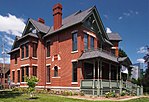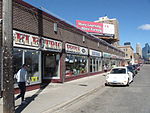The George W. and Nancy B. Van Dusen House is a mansion in the Stevens Square neighborhood of Minneapolis, Minnesota, United States. The owner, George Washington Van Dusen, was an entrepreneur who founded Minnesota's first and most prosperous grain processing and distribution firm in 1883. In 1891, he hired the firm of Orff and Joralemon to build a 12,000-square-foot (1,100 m2) mansion on what was then the southwestern edge of Minneapolis. His house reflects the prosperity achieved by business owners who were making money in the flourishing grain, railroad, and lumber industries in the late 19th century. The mansion was listed on the National Register of Historic Places in 1995.The exterior is built of pink Sioux quartzite quarried near Luverne, Minnesota. The roof and turrets are covered with Maine slate. The mansion is generally within the Richardsonian Romanesque form, but it also has French Renaissance design elements, such as steep roofs, and a soaring, slender turret topped with a copper finial. The interior mixes elements of French, Gothic, Tudor, Romanesque, and Elizabethan styles. It contains ten fireplaces, a grand staircase, large skylights, carved woodwork, parquet floors, and a tile mosaic in the entryway.George Van Dusen was born on July 10, 1826. He married Nancy Barden, his third wife, on November 29, 1860. He started the G.W. Van Dusen & Co. grain company in Rochester, Minnesota, which by 1889 merged with a Minneapolis company to become Van Dusen-Harrington. This eventually became part of the Peavey Company, acquired by ConAgra in 1982. Van Dusen is credited with naming Byron, Minnesota after the town of Port Byron, New York, where he once lived, though his father Laurence had been born in Byron Center, Genesee County, New York.The Van Dusens are said to have survived a tornado that destroyed a previous home and as a result the mansion has some unique features including I-beam construction that supposedly made the home tornado-proof. Additionally, tunnels, which may have been for emergency use, radiated from the building into the yard.












